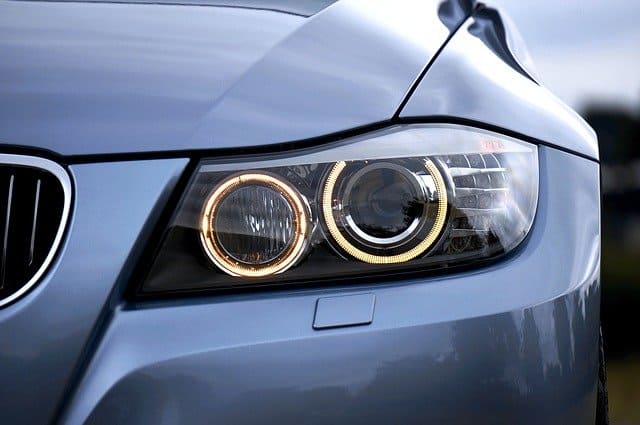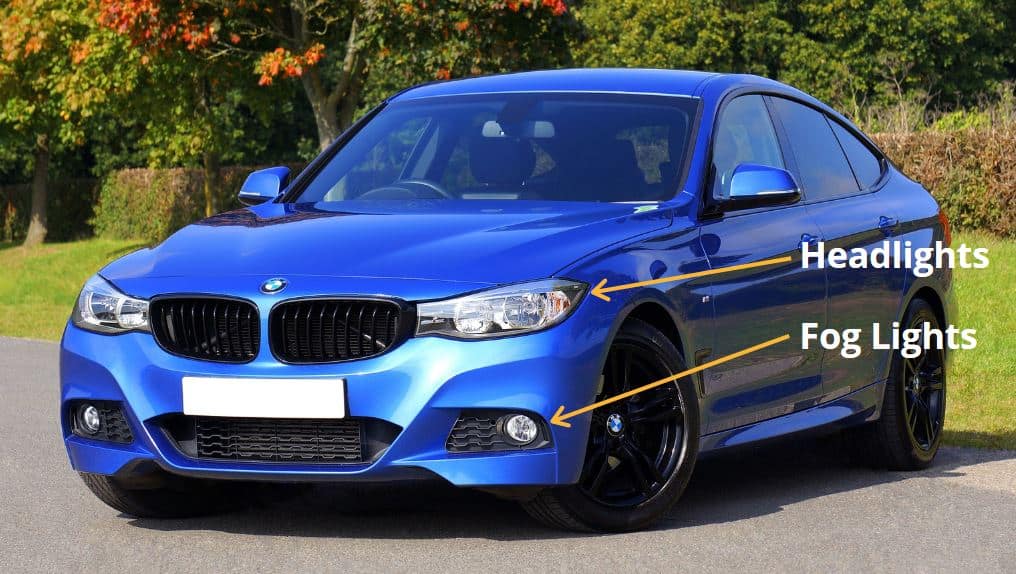Ever been blinded by high beam headlights of a car barreling down the road?
It seems only a certain kind of people tend to do this. Let’s make sure you are not inadvertently blinding someone, or perhaps using the wrong lights of your car at the wrong time.
Headlights are the main driving lights of your car, located in the center of the car, intended to illuminate a long range of the road and cars up ahead. Fog lights are smaller, auxiliary lights, located under the bumper, to light up the road immediately near the car. Fog lights are extremely important for safe driving in foggy conditions.
What Are Headlights?
Headlights are the main white lights on the car’s front and are also referred to as driving lights or low-beam lights.
Turning on the reflector headlights will also turn on other required systems such as the rear taillights, the parking lights, rear-license plate light.
The low-beam headlights of a car are required by the US law to be turned on when it gets dark, usually from sunset to sunrise.
Some US states, such as Tennessee and Georgia, mandate that drivers turn on their headlights 30 mins before and after this time frame.
Similarly, they also need to be on when the visibility is down to less than 200-500 feet due to weather or other conditions. A rule that sometimes applies is that if the vehicle windshield wipers are in use, the headlights also need to be on.
You can read the rules for using headlights by each state here.
Low-beam headlight allows you to see cars, signboards, pedestrians up ahead of your vehicle. According to the US federal regulations, the distance the lights should reach is between 150-200 feet.
High-beam headlights should follow the standard of lighting up to 250-350 feet ahead. High-beams are usually very bright and not turned on when on two-way roads with other drivers passing you.
You need high-beams when traveling in rural, dark roads without many street lights and other traffic. But when you need to switch to low-beam when you get within a range of 500 feet of an oncoming car. Otherwise, it can blind the driver passing by.
Interestingly, there are prohibitions on the use of high beams in foggy conditions, since the high beam will produce intense glare and reduce visibility further for drivers around the car.
What Makes Fog Light A Fog Light?
While your regular headlights light up a large area, their purpose is to illuminate the road and cars ahead of you.
So if there are also weather elements while you’re driving, such as rain, snow, sand, or of course, fog, the headlights will end up shining on them also.
This is not good. When light is shone on these elements, the light reflects back and restricts the driver’s vision.
Fog lights, on the other hand, light up the road beneath the fog. They are placed in both the front and rear of the car.
The front fog lights are located under the front bumper, which means they are pretty low. They are also very multi-functional lights and not just useful in foggy conditions.
The light illuminates the road directly in front or just at the immediate corners by being low on the car. In fact, many people use them to see to the side of the road where the headlight beams do not reach.
Here are a few examples: On winding roads to see ahead of a curvy turn, on roads where animals might run out from the side bushes onto the road, during Halloween, with lots of kids around the road.
Traditionally, the fog lights have come in yellow light, but now they can also be white in color. They tend to be a more rectangular beam of light so that a large horizontal area is covered.
These fog lights are designed with a deflector in the lamp’s body, allowing light to only shine straight and downwards onto the road. The light is cut-off from shining upwards.
They are nested inside the car’s front body so that they don’t shine upwards and produce glare from the weather back into the driver’s eyes. Usually, these fog lights are not a problem for oncoming traffic.
But having them on in clear conditions is highly discouraged and even prohibited in some states in the US.
Los Angeles state police are reminding drivers to keep fog lights off to prevent being fined.
For example, the Minnesota law states the fog lights can be on during clear conditions if, however, the lights are below 30 inches from the road level.
Fog lights can also become a nuisance when car owners swap out the stock fog lights for high illumination, all directional bright white lights. That is why many countries only restrict fog lights to be used in poor visibility, and not at all times.
Similarly, rear fog lights are placed behind the back bumper of the car to indicate your vehicle’s position to the people behind you, without being too bright or intrusive. They don’t have a cut-off deflector and light up the rear evenly.
These lights are red in color. Sometimes the rear fog lights can be as bright as the rear brake lights, and people behind you may think you are braking when you’re not.
So only turn on the rear fog lights during low visibility.
Key Differences
Let’s look at the key differences between headlights and fog lights, in terms of the function they serve, their color and any laws informing their use. Always check your local state laws for specifics.
| Headlights | Fog Lights |
|---|---|
| Mandated by law and standard in all cars in the US | Not mandated by US law and base models don’t have them, but highly recommended |
| Need to be turned on during dark hours, from sunset to sunrise | Need to be on only during low-visibility weather conditions, and not clear weather |
| Circular, long-range, projection lights to illuminate the road and cars in front of you | Rectangular, short-range, scatter lights for only the road directly in front and immediate sides of the car |
| Placed on the centre of the car directed towards the middle of your vision | Placed low on the car to prevent glare from reflection off fog |
| Always white | Are usually amber or yellow but can be white |
Are Fog Lights Mandatory?
Rear fog lights are not mandatory in the US, but are in fact in Europe. In the US, both fog lights, front and rear, are considered auxiliary or supplementary lights and so they are not mandatory.
In fact, base and low-options cars in the US do not come with standard fog lights. But people who are conscious about safety get them installed from the dealer as an add-on option.
Can You Use Fog Lights As Day Running Light?
Almost all new cars in the US come stocked with Day Running Lights or DRLs. These increase your vehicle’s visibility for oncoming traffic and for drivers in front of you looking in the rearview mirror. They stay on even if your headlights are off.
They are automatic lights, sometimes the parking lights, or the slim LED lights framing the main projector headlights and taillights.
On the one hand, using fog lights unnecessarily during the day is not recommended. However, non-functioning DRLs put you in a different position.
Since you need to be visible to the cars around you even in the daytime, it is okay to leave your fog lights on to indicate the position and speed of your car’s approach.
On the flip side, if your fog lights are temporarily not working, or say your car doesn’t even have them, DRLs are not a suitable alternative for them. DRLs do not offer the same brightness or beam angle fog lights have.
If the visibility is low due to non-foggy conditions, turning on the regular headlights might be enough. But if it is heavily pouring or foggy, it is better to stay safe and wait for your fog lights to be repaired or installed.
Final Words
Monitor the light systems in your car to ensure everything is working as it should.
Most US states have their own laws about what lights need to be and conditions and times. Stay informed of the local laws, so you don’t break any laws, and more importantly, aren’t causing a nuisance to fellow drivers.
Are there fog lights installed in your car?
Did you need to use headlights during low visibility?
Let me know in the comment how the two lights perform for you.
Claim your 10% discount on the first order with Lasfit

- Replace your dim halogen headlights with bright LED
- LED lighting increases your visibility on the road during the day, and for you in the night
- Select LED lighting that is exactly designed for your car
- Buy with confidence having 45 days money back guarantee
Claim 10% off on your first order over $50, using the promo-code “FIRSTTIME10“!




